25.04.2018
By Rosa Lleó, Porto Alegre, Brazil
April 6, 2018 – June 3, 2018
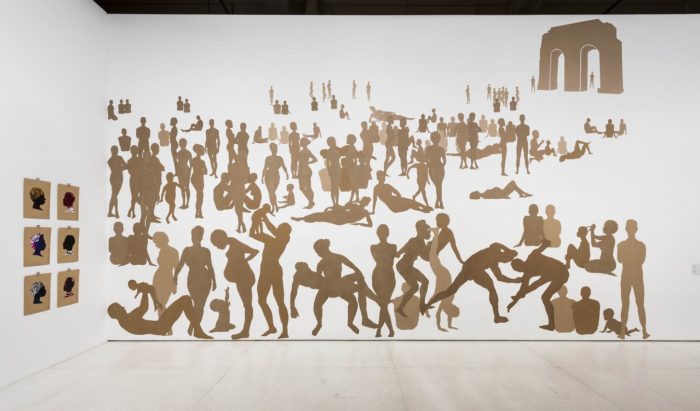
Porto Alegre is not a tourist destination. It is a medium-sized South-American town, with a colonial center and tall, austere modernist buildings. The city is in Brazil, but could as well be in Uruguay or Argentina. The creation of the Mercosul Biennial and the Iberê Camargo Foundation in 1996 and 1995, respectively, gave the city and the larger area some importance in the field of contemporary art. Editions curated by José Roca (2011) or Sofía Hernández Chong Cuy (2013) placed it at the heart of the international art scene. More recent editions have had ups and downs due to the economic situation and the unstable political climate of the host country.
This 11th edition was supposed to take place in 2017, but was rescheduled for this year. Head Curators are Paula Borghi and German art critic and curator Alfons Hug, who has been living in Brazil for several years and has been twice curator of the São Paulo Biennial. This year’s budget is relatively modest as compared to other editions, but the title promises reflection on a large scale. The Atlantic Triangle focuses on tense cultural relations within the triangle formed by Africa, America and Europe. The concept is of historical significance, as it inevitably tackles unresolved issues in the relationship between the african and the indigenous, most importantly, albeit not exclusively, in Brazil. Also, we must not forget that the social context is rather strained at the moment. For this reason, communication about this event is essential in order to reach a general public who has but few possibilities to question the status quo imposed by social networks and TV.
While I am writing this text, an article titled Afro-Atlantic Histories, about the work carried out by the São Paulo Museum of Art, is being published in this same magazine. Inevitably, the first thing that comes to mind are questions: how to work on this subject and say something new or relevant? How to translate these tensions into not only artistic but also curatorial language? However, from my position as a curator who is not familiar with many of the artists, nor their contexts, I was missing a certain amount of information about each of the projects presented at the biennial. I believe that this case is not about not imposing a narrative, but rather that it could undermine them. All the works function on a visual level within the discourse, but it has been repeatedly difficult to learn more about each of them. My personal research has allowed me to tie up loose ends, and the works have been gaining in depth. Interestingly, the only works that give information are those that are potentially controversial, such as Vasco Araujo’s, which presents texts of the colonial era. These texts, if read superficially, come over as thoroughly racist.
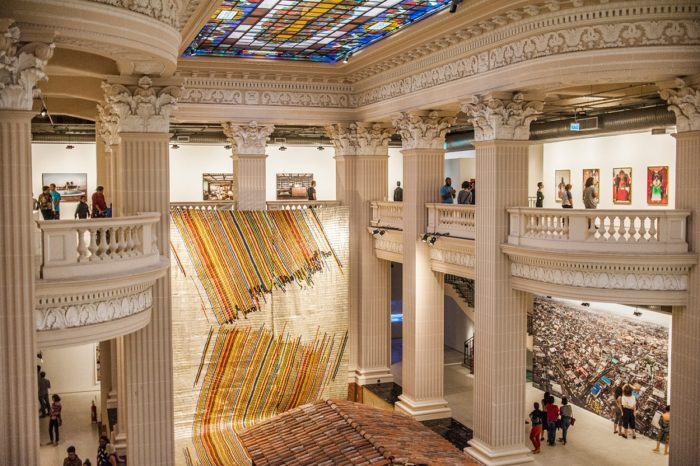
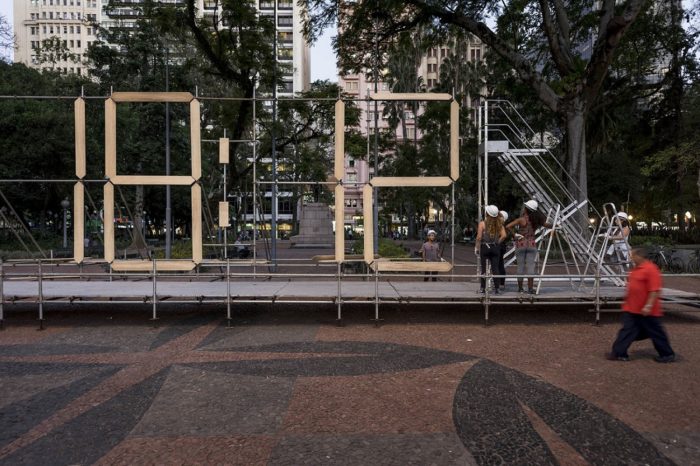
The Biennial is located in three different places and some in situ projects here and there across the city and its surroundings. At the MARGS (Rio Grande do Sul Museum of Art), the questions outlined previously are tackled from a historical perspective, more specifically through the themes of transatlantic travels and the slave trade. A huge mural by Arjan Martins (Rio de Janeiro, 1960) dominates the central room and refers to these issues. As an Afro-Brazilian artist, his mental map of the conquest is personal and blurred. It can work as a good example to rethink history beyond hegemonic and systematic discourses. Similarly, the fascination for exploration and conquest is metaphorically resolved in Vostok, a movie by Leticia Ramos (1976, Santo Antônio da Patrulha, BR). The movie shows a fake submarine trip in a prehistoric lake of Antarctica, actually set in a small pool with a home-made submarine model.
The adjacent building, headquarters of Santander Cultural, mainly presents large-scale installations by Africa’s most internationally acclaimed—and bankable—artists, such as El Anatsui and Ibrahim Mahama. Among these installations, the beautiful geometries of the passing by Youssef Limoud (1964, Giza, Egypt) stand out, formed by functionless objects that become fragile sculptures of waste or ruins. This type of reality is actually closely linked to the destruction caused by men, nature or time. On the formal level, the structures seem futurist, but they are also a reminder of the precarious present.
If this space seeks to offer a vision of the African continent and its cultural reality, photography is another tool of colonial heritage which currently serves to document and archive a history built from its own peoples. This is the case of George Osodi’s pictures of Nigerian kings: portraits of tired men, striving to keep a certain halo of solemnity in a very different postcolonial reality. Or the beautiful compositions of everyday images by Vivane Sassen. Not African, but nevertheless linked to blackness, the very plain paintings of the Sinos e caprinos series by Dalton Paula (Brasilia, 1982), introduce us to black territories and symbologies linked to the mystical and the familiar.
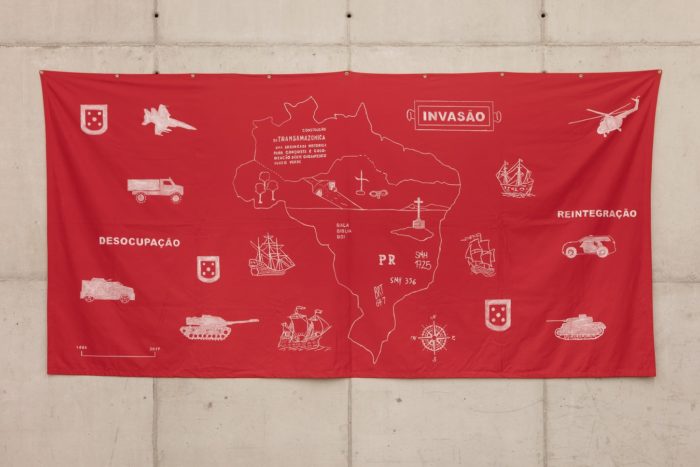
The third space is the ground floor of the Rio Grande do Sul Memorial. This is actually where the discourse reaches contemporary language and some freshness. The works speak of creolization through technology, languages, music and religion. Two paintings by Paulo Nimer Pjota (1988, Sao José de Rio Preto, BR) bring to us the contemporary imagery of the streets, with car tuning label designs or small replicas of indigenous sculptures. With different results but the same contemporary quality, Marco Montiel-Soto (Maracaibo, Venezuela, 1976) presents an installation titled Mal de mar hacia un triste trópico [Seasick towards a sad tropic]: in the distance of the eighth island. Montiel-Soto assembled a series of images, drawings and texts with maps of a poetic territory in the Atlantic, made of memories and objects collected by the artist. The works feature layers of random information, hinting at contemporary digital reality. There is also room for the indigenous peoples’ voices, through Anna Azavedo’s documentary Nossa vida nao é um jogo [Our life is not a game]. The film presents images of the World Indigenous Games in Palmas, Brazil, during which a constitutional amendment was passed, shifting the right to demarcate indigenous lands from the executive to the Brazilian Congress, which is heavily influenced by the powerful extensive agriculture lobby. The latter has always opposed the protection of indigenous lands.
Another exhibition program is worth mentioning here, with the same economy of means, if possible less dense, and more open: the Iberê Camargo Foundation—an absolute highlight, beyond Alvaro Siza’s architectural oeuvre—proposes exhibitions which are almost contrapuntal to the biennial. In addition, it has become increasingly difficult to find museums hosting different exhibitions which start from a common point and develop a discourse experimenting with forms and spaces, hereby showing a more comprehensive curatorial work.
Here, the founding discourse is less imposed, but points towards many of the questions tackled by the biennial, which remain subtly implicit in many of the exhibited works. The collective exhibition Unânime Noite is based on Borges’ story The Circular Ruins, to create an open essay on the limits of the exhibition in time and space. It is a reflection on night, the other, the dark side, or what is difficult to define. It hints at that which is not easy, and does not enter political discourse. The highlight of this exhibition is the creation of an amorphous landscape, with pieces that reach beyond our preconceived scheme on the form and duration that artworks should have. A multicolored light (Elena Narbutaite), towels which look like flying carpets (Daniel Jacoby), a small sculpture hidden among the trees that you can only see through the window (Eduardo Haesbaert) or an immense encyclopedia of texts (Débora Bolsoni). The sculptures by Ana Mazzei (1980, São Paulo) are anatomical supports to make sculptural poses with the body. The video by Guerreiro do Divino Amor (1983, Rio de Janeiro), Esfinge, shows a black sphinx dressed in gold with a green fluorescent background.
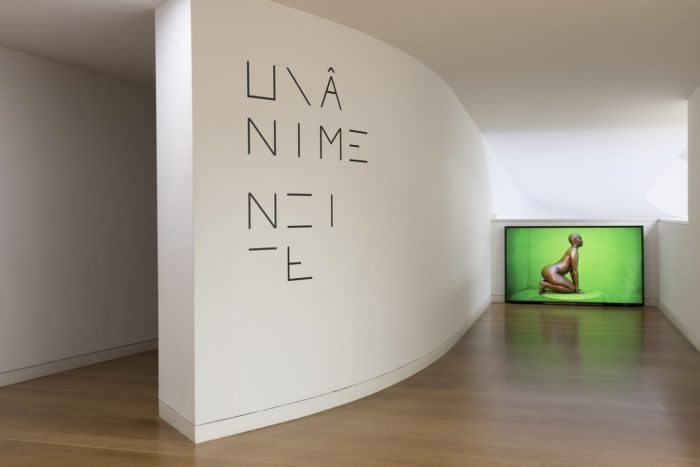
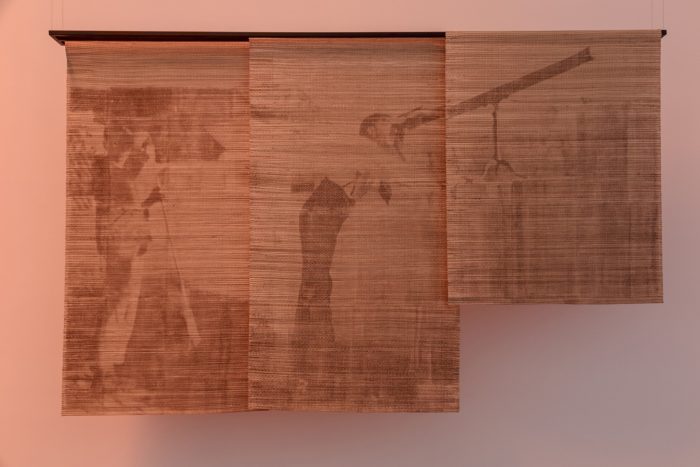
In parallel, Daniel Frota’s individual exhibition also explores an anomalous moment: the 1919 solar eclipse as experienced in the small town of Sobral, in the middle of the Brazilian sertão, a semi arid area which brings to mind the emptiness of large landscapes, and the drought which forces the poor to migrate to more fertile areas. This game of light and shadow also works on a metaphorical level, hinting at the relationship between science and religious beliefs in Brazil. Even if this case refers to an episode of the beginning of the 20th century, the issue seems to be coming back with vigor. The exhibition shows a video which works as a kind of documentary about the artist’s trip to this town, and the narration of the episode by two “repentistas”, or rhyme singers, who tell their own version of the incident. The contiguous room presents an elegant sculptural composition of abstract forms and flashing light.
To conclude, even if the biennial proposes a discourse of proximity by giving voice to uncountable concrete cultures, the curatorial point of view by Bernardo de Souza in Unânime Noite seems to suggest the contrary: to begin from scratch, from fiction, further away from what is human. The gallery text, written by Lituanian artist and curator Raimundas Malasauskas begins with the following sentence: “You know that in the coming hours you will become a human. Nobody has ever told you what it is like or how to proceed in such situation”. A resource to form thoughts by means of the uncanny, or even to reach the shape of another, non rational perspective out of time and space. Even if only in words, for the time being.
*Translation by Ambar Geerts
Comments
There are no coments available.